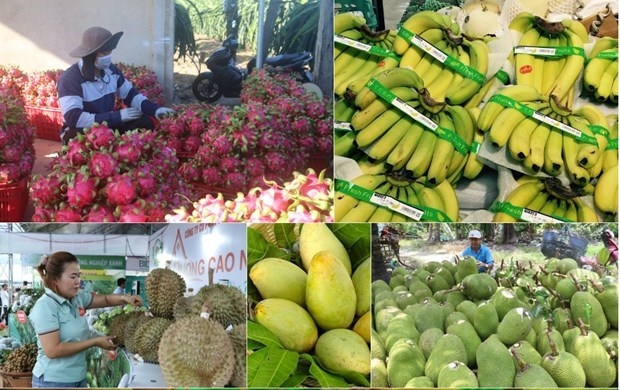Eight-month fruit and vegetable exports earn close to US$4.6 billion
Society – Economy - Ngày đăng : 08:15, 25/08/2024
China remains the largest buyer of Vietnamese fruit and vegetables
According to the Vietnam Fruit and Vegetable Association (Vinafruit) in August 2024, Vietnam's fruit and vegetable exports reached over US$700 million, up 26.8% over the previous month and up 50.8% over the same period from last year.
This is one of the months recording the highest export value of fruit and vegetables of the year as it fell during the peak durian harvest period in the Central Highlands.
China continues to be the largest fruit and vegetable import market with nearly US$2.5 billion from Vietnam during the past 7 months of the year, accounting for 64% of the market share. It is followed by the United States and the Republic of Korea (RoK) with export value reaching US$189 and 188 million, up 31% and 51%, accounting for 4.88% and 4.87% of the market share, respectively.
Notably, Thailand has risen to fourth place in the list of markets importing fruit and vegetables from Vietnam. During the reviewed period, fruit and vegetable exports to Thailand raked in US$123 million, up 70% on- year.
Dang Phuc Nguyen, general secretary of the Vietnam Fruit and Vegetable Association said that recently, Thailand has increased its import of durian from Vietnam, including frozen durian. This has boosted the export value to this market. Some shipments of Vietnamese durian imported by Thailand will be used for exports to China.
Continuing to bolster exports to Northeast Asian market
According to Dang Phuc Nguyen, besides building brands and securing foothold in the traditional Chinese market, the fruit and vegetable industry is increasingly boosting market expansion in the Northeast Asia region.
Accordingly, in this market area, China and the RoK are the two countries with the highest fruit and vegetable export turnover of Vietnam. China is the leading market, accounting for 64% of total export turnover, up 22% over the same period, trailed by the RoK, up 55% on-year.
In the future, Northeast Asia will be a strategic market for Vietnamese fruit and vegetables. Exporters will not only benefit from tariffs but also reduce transportation and logistics costs compared to markets such as the EU and the US.
According to industry experts, when free trade agreements (FTAs) come into effect and import taxes are reduced, countries will impose technical barriers. This requires Vietnamese producers and exporters to constantly update import regulations of markets in order to promptly respond.
It is expected that by the end of 2024, the total area of fruit trees nationwide will reach roughly 1.29 million hectares, an increase of about 20,000 hectares compared to 2023. At this time, many kinds of fruit in the Mekong Delta are entering the main season such as durian, dragon fruit, pineapple, watermelon, mango, longan, and lychee which will create a large amount of goods for both fresh fruit exports and deep processing.
Vietnam's fruit and vegetable export activities are anticipated to enjoy advantages in the coming time thanks to abundant domestic supply, and growing demand from traditional and potential markets. With the current growth momentum, the country’s fruit and vegetable exports is likely to hit a record export turnover of US$7 billion this year.

